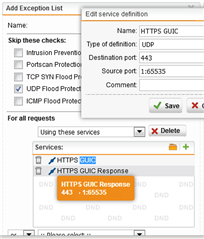So to get straight to the point, I'm running Sophos UTM (FW Ver.: 9.203-3, Virtual) Home License and, as the thread title shows, browser-based Google products are affected by the IPS and some of its traffic are being tagged by the IPS as "UDP flood" firewall rule 60013, which is to Drop UDP_FLOOD attempts.
As a result, some Google products will be capped at 2mbps download speeds. Strangely enough, it only happens to one wired client and not any virtualised clients nor wireless clients (so this means neither the LG Smart TV running YouTube nor the Android smartphone running Google Maps experience this issue.) When this plays out:
- YouTube will load videos at 2mbps, causing buffer to 1080p videos and less often to 720p videos; and
- Google Maps will load its chunks of map and image data slowly
Now, I can definitely turn off UDP flood protection, but that leaves a gigantic gap on my network. It's probably not the best practice when the UTM is responsible as the gateway between the Internet and my network at home. You now understand why this is probably something I would consider to avoid. I had disabled it for a minute and it definitely increased the loading speeds to what my ISP provides, which is 30x more than what it was throttling me to. As of right now, it's enabled.
Has anyone else experienced this issue? Has anyone found a fix for this? This started happening probably around the time where the OpenSSL Heartbleed vulnerability was discovered, if not a month or two before it.
UPDATE: Alright, so here's what's getting hit by IPS so that we all have that general idea...
IP of Google is the source IP.
WAN IP is the destination.
Action is UDP Flood
Source Port: 443
Destination Port: Some random port on the 50000~60000s.
Last time I checked, 443 isn't exactly UDP for the nature of what's being transported and a corporation like Google would keep atop for any such UDP floods to prevent it from happening.
Second Update:
Please don't tell me this is too difficult. It has to be some simple explanation.
2014:07:14-16:40:20 core ulogd[4786]: id="2105" severity="info" sys="SecureNet" sub="ips" name="UDP flood detected" action="UDP flood" fwrule="60013" initf="eth1" srcmac="[Source MAC]" dstmac="[Destination MAC]" srcip="206.111.13.173" dstip="[My WAN IP]" proto="17" length="1228" tos="0x00" prec="0x00" ttl="57" srcport="443" dstport="55971"
Thanks
This thread was automatically locked due to age.



